
eBook - ePub
Atlas of Equine Ultrasonography
- English
- ePUB (mobile friendly)
- Available on iOS & Android
eBook - ePub
Atlas of Equine Ultrasonography
About this book
The only visual guide to equine ultrasonography based on digital ultrasound technology. Atlas of Equine Ultrasonography provides comprehensive coverage of both musculoskeletal and non-musculoskeletal areas of the horse. Ideal for practitioners in first opinion or referral practices, each chapter features normal images for anatomical reference followed by abnormal images covering a broad range of recognised pathologies. The book is divided into musculoskeletal, reproductive and internal medicine sections and includes positioning diagrams demonstrating how to capture optimal images. With contributions from experts around the world, this book is the go-to reference for equine clinical ultrasonography.
Key features include:
- Pictorially based with a wealth of digital ultrasound images covering both musculoskeletal and non-musculoskeletal areas and their associated pathologies.
- Each chapter begins with a discussion of normal anatomy and demonstrates how to obtain and interpret the images presented.
- A video library of over 50 ultrasound examinations is available for streaming or download and viewing on-the-go. Access details are provided in the book.
Frequently asked questions
Yes, you can cancel anytime from the Subscription tab in your account settings on the Perlego website. Your subscription will stay active until the end of your current billing period. Learn how to cancel your subscription.
No, books cannot be downloaded as external files, such as PDFs, for use outside of Perlego. However, you can download books within the Perlego app for offline reading on mobile or tablet. Learn more here.
Perlego offers two plans: Essential and Complete
- Essential is ideal for learners and professionals who enjoy exploring a wide range of subjects. Access the Essential Library with 800,000+ trusted titles and best-sellers across business, personal growth, and the humanities. Includes unlimited reading time and Standard Read Aloud voice.
- Complete: Perfect for advanced learners and researchers needing full, unrestricted access. Unlock 1.4M+ books across hundreds of subjects, including academic and specialized titles. The Complete Plan also includes advanced features like Premium Read Aloud and Research Assistant.
We are an online textbook subscription service, where you can get access to an entire online library for less than the price of a single book per month. With over 1 million books across 1000+ topics, we’ve got you covered! Learn more here.
Look out for the read-aloud symbol on your next book to see if you can listen to it. The read-aloud tool reads text aloud for you, highlighting the text as it is being read. You can pause it, speed it up and slow it down. Learn more here.
Yes! You can use the Perlego app on both iOS or Android devices to read anytime, anywhere — even offline. Perfect for commutes or when you’re on the go.
Please note we cannot support devices running on iOS 13 and Android 7 or earlier. Learn more about using the app.
Please note we cannot support devices running on iOS 13 and Android 7 or earlier. Learn more about using the app.
Yes, you can access Atlas of Equine Ultrasonography by Jessica A. Kidd, Kristina G. Lu, Michele L. Frazer, Jessica A. Kidd,Kristina G. Lu,Michele L. Frazer in PDF and/or ePUB format, as well as other popular books in Medicine & Equine Veterinary Science. We have over one million books available in our catalogue for you to explore.
Information
SECTION 1
Musculoskeletal
CHAPTER ONE
Ultrasonography of the Foot and Pastern
1University of Pretoria, Onderstepoort, South Africa
2The Royal Veterinary College, North Mymms, Hatfield, UK
The Foot
Lameness associated with the foot is common and routinely evaluated using radiography. However, many causes of lameness are associated with soft tissue pathology where there are no or minimal radiographic changes. While magnetic resonance imaging (MRI) has become the imaging modality of choice for identifying such soft tissue causes, MRI is costly and not always available. Therefore, ultrasonography is a logical imaging modality to consider but its use is compromised by the presence of the hoof capsule, which precludes imaging through it. However, there are three ultrasonographic windows where images can be obtained of structures of the foot – proximal to the coronary band palmarly and dorsally, and transcuneally/transsolarly.
Ultrasonography Proximal to the Coronary Band
A number of structures within the foot extend proximal to the coronary band and so lend themselves to ultrasonographic examination.
Preparation
The hair should be clipped and cleaned as for other ultrasound examinations. Gel should be rubbed it the area and left for a few minutes to improve contact as this is often limiting.
Technique
For the palmar aspect of the foot a small footprint transducer (ideally a curvilinear probe) can be placed longitudinally between the bulbs of the heel, with the foot placed on a wooden wedge (as used for foot radiography – Figure 1.1) so as to have the fetlock partially flexed and the foot extended. This allows the assessment of the deep digital flexor tendon (DDFT), the palmar pouch of the distal interphalangeal (DIP) joint, the “T” ligament, and the navicular bursa down to the level of the proximal border of the navicular bone (Figure 1.2). However, the DDFT is off-incidence to the ultrasound beam and hence is hypoechoic, and the imaging window incorporates only the middle portion of the DDFT, making identification of DDFT tears, most commonly present in the lobes, difficult.


For the dorsal, medial, and lateral aspects, the transducer is positioned both transversely adjacent to the coronary band and longitudinally overlying the coronary band (Figure 1.3) and moved from the dorsal aspect to the dorsomedial and dorsolateral aspects where the dorsal joint capsule and collateral ligaments of the DIP joint (Figure 1.4) can be imaged immediately proximal to the coronary band. The collateral ligaments traverse the coronary band and so only the more proximal parts of the ligament are visible ultrasonographically. Care should be taken to ensure the transducer is on-incidence to the collateral ligament as it is easy to generate off-incidence artifacts in the ligaments that can resemble pathology (Figure 1.5). Further caudally lie the collateral cartilages, which are hypoechoic but can show areas of ossification (and therefore acoustic shadowing).
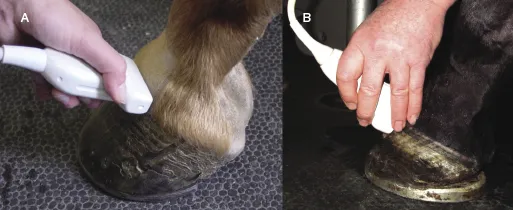

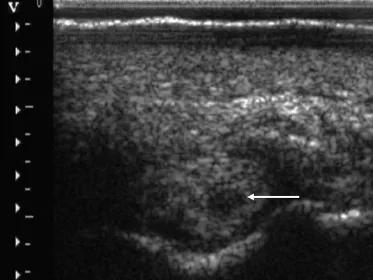
Ultrasonographic Abnormalities
Via the palmar window, only chronic DDFT pathology, where there is retained echogenicity and/or mineralization within the off-incidence hypoechoic DDFT, can usually be visualized (Figure 1.6), limiting this view for comprehensive evaluation of the DDFT in this region of the foot. In some cases, DDFT pathology will extend sufficiently proximally to be visible in standard views within the distal pastern (see Pastern, later in this chapter).
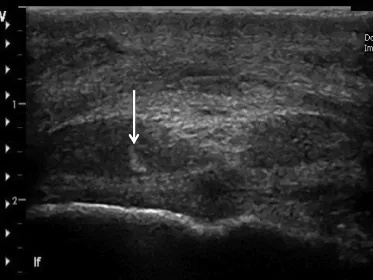
Abnormalities of the distal interphalangeal joint can result in changes to the dorsal pouch which are visible ultrasonographically – both distension and synovial thickening (Figure 1.7) as well as osteophytosis in cases of osteoarthritis (Figure 1.8). Where ultrasonography of this region carries the most useful imaging is for collateral ligament desmitis, especially when there is palpable swelling in the region of the ligament (dorsomedially or dorsolaterally) at the level of the coronary band. Ultrasonographic abnormalities vary between enlargement and complete rupture (Figure 1.9).
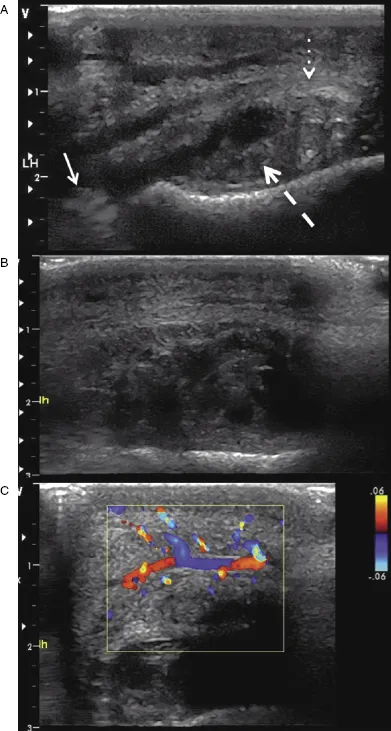
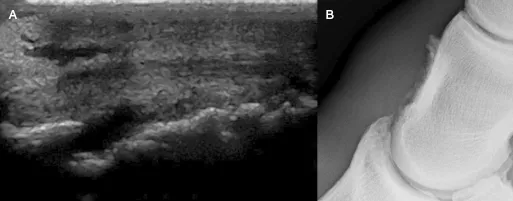

Transsolar and Transcuneal Ultrasonography
The third phalanx (P3), distal sesamoid bone (navicular bone) (DSB), navicular bursa (NB), implantation of the deep digital flexor tendon (DDFT), distal sesamoid impar ligament (DSBIL),...
Table of contents
- Cover
- Table of Contents
- Dedication
- Title page
- Copyright page
- List of Contributors
- About the Companion Website
- Introduction
- SECTION 1: Musculoskeletal
- SECTION 2: Reproduction
- SECTION 3: Internal Medicine
- Index
- End User License Agreement